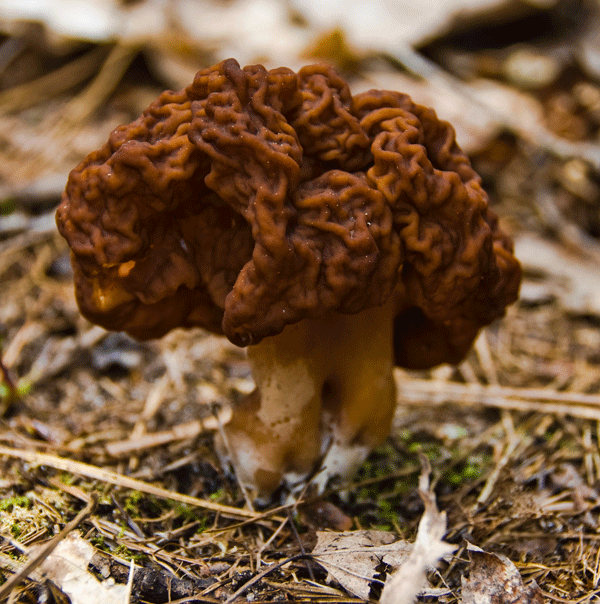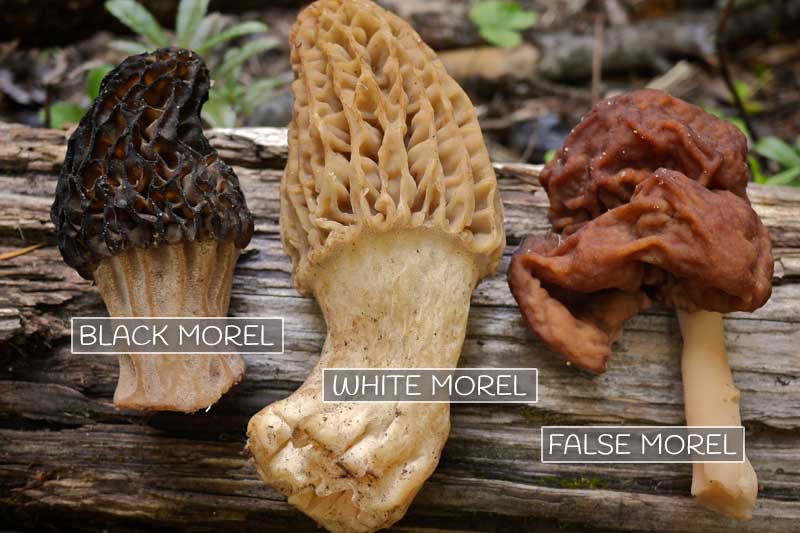Watch out for false morels.
The most commonly misidentified mushroom that mushroom hunters find when looking for morels is the false morel. There is a bit of debate over whether false morels are poisonous as people react differently to the mushroom's constituents, however, it is now known that they contain gyromitrin, a toxic and carcinogenic organic compound, which is hydrolyzed in the body into monomethylhydrazine (MMH)1. False morels have been known to cause sickness, malaise and vomiting and on the odd occasion death! When you hunt for morels, look out for the false morel's key distinguishing features:
- Mottled, ugly, distorted cap with no ridges.
- Looks more like a brain - more rounded and wider.
- Darker orange/red colouration.
- Solid inside, often quite heavy in comparison to a morel.
- The stem inside goes all the way to the top of the cap.
- The false morel's stem is usually filled with cotton-like fibres.
- With a small twist, the cap will fall right off.
The false morel mushroom grows in close proximity to the true morel mushroom and they appear around springtime. Common names for the false mushrooms include:
- 'red-mushroom'
- 'beefsteak mushroom'
- 'lorchel'

Characteristics of the false morel mushroom
The false morel mushroom has peculiar characteristics. We take a look at some of those characteristics:
- The head or cap of the false morel has folded wrinkles and is brittle when touched.
- When young the false morel is reddish and as it ages it changes to reddish-brown.
- They are often two to ten inches in size.
- A fail-safe method of determining a false morel is by slicing through it (longitudinally). Instead of being hollow, like its non-poisonous tasty cousin, false morel mushrooms are meaty, thick and spongy on the inside.
False Morels are Toxic!
A point to note is that false morels should not be eaten, especially when raw. When eaten raw, the active poisonous ingredient is metabolized into monomethylhydrazine which is rocket fuel! This causes immense damage to the central nervous system, the gastrointestinal tract, and the liver. In fact, statistics indicate that two to four percent of the fatal cases associated with mushrooms in North America are associated with the false morel mushroom.
Some people would prefer to boil the false mushroom to get rid of the poisonous substances. They believe the poison will escape through evaporation and whatever is left will be drained more than once after boiling. It is important to guard oneself against inhaling any of the fumes from the boiling pot. This is because, in most cases, fumes have a greater concentration of the poison and will have the same adverse effects on any person who ingests the poison. Therefore, take heed so that you are not found the victim of false morel mushrooms.
References
1Karlson-Stiber C, Persson H (2003). "Cytotoxic fungi—an overview". Toxicon. 42 (4): 339–349. doi:10.1016/S0041-0101(03)00238-1. PMID 14505933.

